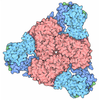[English] 日本語
 Yorodumi
Yorodumi- PDB-4ei5: Crystal Structure of XV19 TCR in complex with CD1d-sulfatide C24:1 -
+ Open data
Open data
- Basic information
Basic information
| Entry | Database: PDB / ID: 4ei5 | |||||||||
|---|---|---|---|---|---|---|---|---|---|---|
| Title | Crystal Structure of XV19 TCR in complex with CD1d-sulfatide C24:1 | |||||||||
 Components Components |
| |||||||||
 Keywords Keywords | IMMUNE SYSTEM / sulfatide / lipid / CD1d / NKT typeII / TCR | |||||||||
| Function / homology |  Function and homology information Function and homology informationregulation of immature T cell proliferation in thymus / positive regulation of NK T cell activation / positive regulation of NK T cell differentiation / NK T cell differentiation / endogenous lipid antigen binding / antigen processing and presentation, exogenous lipid antigen via MHC class Ib / positive thymic T cell selection / positive regulation of macrophage activation / Endosomal/Vacuolar pathway / DAP12 interactions ...regulation of immature T cell proliferation in thymus / positive regulation of NK T cell activation / positive regulation of NK T cell differentiation / NK T cell differentiation / endogenous lipid antigen binding / antigen processing and presentation, exogenous lipid antigen via MHC class Ib / positive thymic T cell selection / positive regulation of macrophage activation / Endosomal/Vacuolar pathway / DAP12 interactions / Antigen Presentation: Folding, assembly and peptide loading of class I MHC / ER-Phagosome pathway / DAP12 signaling / Immunoregulatory interactions between a Lymphoid and a non-Lymphoid cell / antigen processing and presentation / positive regulation of interleukin-4 production / regulation of immune response / cellular defense response / T cell receptor binding / Neutrophil degranulation / positive regulation of interleukin-2 production / cellular response to iron(III) ion / negative regulation of forebrain neuron differentiation / antigen processing and presentation of exogenous protein antigen via MHC class Ib, TAP-dependent / iron ion transport / peptide antigen assembly with MHC class I protein complex / regulation of iron ion transport / regulation of erythrocyte differentiation / HFE-transferrin receptor complex / response to molecule of bacterial origin / MHC class I peptide loading complex / T cell mediated cytotoxicity / positive regulation of T cell cytokine production / antigen processing and presentation of endogenous peptide antigen via MHC class I / MHC class I protein complex / positive regulation of receptor-mediated endocytosis / negative regulation of neurogenesis / cellular response to nicotine / positive regulation of T cell mediated cytotoxicity / multicellular organismal-level iron ion homeostasis / positive regulation of type II interferon production / phagocytic vesicle membrane / negative regulation of epithelial cell proliferation / sensory perception of smell / positive regulation of cellular senescence / late endosome / T cell differentiation in thymus / negative regulation of neuron projection development / protein refolding / protein homotetramerization / amyloid fibril formation / intracellular iron ion homeostasis / learning or memory / early endosome / lysosome / endosome membrane / lysosomal membrane / innate immune response / external side of plasma membrane / structural molecule activity / Golgi apparatus / protein homodimerization activity / extracellular space / cytosol Similarity search - Function | |||||||||
| Biological species |   Homo sapiens (human) Homo sapiens (human) | |||||||||
| Method |  X-RAY DIFFRACTION / X-RAY DIFFRACTION /  SYNCHROTRON / SYNCHROTRON /  MOLECULAR REPLACEMENT / MOLECULAR REPLACEMENT /  molecular replacement / Resolution: 3.1 Å molecular replacement / Resolution: 3.1 Å | |||||||||
 Authors Authors | Patel, O. / Gras, S. / Rossjohn, J. | |||||||||
 Citation Citation |  Journal: Nat.Immunol. / Year: 2012 Journal: Nat.Immunol. / Year: 2012Title: Recognition of CD1d-sulfatide mediated by a type II natural killer T cell antigen receptor. Authors: Patel, O. / Pellicci, D.G. / Gras, S. / Sandoval-Romero, M.L. / Uldrich, A.P. / Mallevaey, T. / Clarke, A.J. / Le Nours, J. / Theodossis, A. / Cardell, S.L. / Gapin, L. / Godfrey, D.I. / Rossjohn, J. | |||||||||
| History |
|
- Structure visualization
Structure visualization
| Structure viewer | Molecule:  Molmil Molmil Jmol/JSmol Jmol/JSmol |
|---|
- Downloads & links
Downloads & links
- Download
Download
| PDBx/mmCIF format |  4ei5.cif.gz 4ei5.cif.gz | 684.7 KB | Display |  PDBx/mmCIF format PDBx/mmCIF format |
|---|---|---|---|---|
| PDB format |  pdb4ei5.ent.gz pdb4ei5.ent.gz | 568.9 KB | Display |  PDB format PDB format |
| PDBx/mmJSON format |  4ei5.json.gz 4ei5.json.gz | Tree view |  PDBx/mmJSON format PDBx/mmJSON format | |
| Others |  Other downloads Other downloads |
-Validation report
| Summary document |  4ei5_validation.pdf.gz 4ei5_validation.pdf.gz | 2 MB | Display |  wwPDB validaton report wwPDB validaton report |
|---|---|---|---|---|
| Full document |  4ei5_full_validation.pdf.gz 4ei5_full_validation.pdf.gz | 2 MB | Display | |
| Data in XML |  4ei5_validation.xml.gz 4ei5_validation.xml.gz | 58.6 KB | Display | |
| Data in CIF |  4ei5_validation.cif.gz 4ei5_validation.cif.gz | 78.3 KB | Display | |
| Arichive directory |  https://data.pdbj.org/pub/pdb/validation_reports/ei/4ei5 https://data.pdbj.org/pub/pdb/validation_reports/ei/4ei5 ftp://data.pdbj.org/pub/pdb/validation_reports/ei/4ei5 ftp://data.pdbj.org/pub/pdb/validation_reports/ei/4ei5 | HTTPS FTP |
-Related structure data
| Related structure data |  4ei6SC  2akrS S: Starting model for refinement C: citing same article ( |
|---|---|
| Similar structure data |
- Links
Links
- Assembly
Assembly
| Deposited unit | 
| ||||||||
|---|---|---|---|---|---|---|---|---|---|
| 1 | 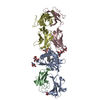
| ||||||||
| 2 | 
| ||||||||
| Unit cell |
|
- Components
Components
-Protein , 4 types, 8 molecules AEBFCGDH
| #1: Protein | Mass: 34662.012 Da / Num. of mol.: 2 / Fragment: UNP residues 19-297 Source method: isolated from a genetically manipulated source Source: (gene. exp.)   Trichoplusia ni (cabbage looper) / References: UniProt: P11609 Trichoplusia ni (cabbage looper) / References: UniProt: P11609#2: Protein | Mass: 11660.350 Da / Num. of mol.: 2 / Fragment: UNP residues 21-119 Source method: isolated from a genetically manipulated source Source: (gene. exp.)   Trichoplusia ni (cabbage looper) / References: UniProt: P01887 Trichoplusia ni (cabbage looper) / References: UniProt: P01887#3: Protein | Mass: 23209.518 Da / Num. of mol.: 2 / Fragment: extracellular domain (SEE REMARK 999) Source method: isolated from a genetically manipulated source Source: (gene. exp.) Mus musculus, Homo sapiens / Plasmid: pET30 / Production host:  #4: Protein | Mass: 28080.617 Da / Num. of mol.: 2 / Fragment: extracellular domain (SEE REMARK 999) Source method: isolated from a genetically manipulated source Source: (gene. exp.) Mus musculus, Homo sapiens / Plasmid: pET30 / Production host:  |
|---|
-Sugars , 4 types, 6 molecules 
| #5: Polysaccharide | alpha-D-mannopyranose-(1-3)-beta-D-mannopyranose-(1-4)-2-acetamido-2-deoxy-beta-D-glucopyranose-(1- ...alpha-D-mannopyranose-(1-3)-beta-D-mannopyranose-(1-4)-2-acetamido-2-deoxy-beta-D-glucopyranose-(1-4)-2-acetamido-2-deoxy-beta-D-glucopyranose Source method: isolated from a genetically manipulated source | ||||
|---|---|---|---|---|---|
| #6: Polysaccharide | Source method: isolated from a genetically manipulated source #7: Polysaccharide | beta-D-mannopyranose-(1-4)-2-acetamido-2-deoxy-beta-D-glucopyranose-(1-4)-2-acetamido-2-deoxy-beta- ...beta-D-mannopyranose-(1-4)-2-acetamido-2-deoxy-beta-D-glucopyranose-(1-4)-2-acetamido-2-deoxy-beta-D-glucopyranose | Source method: isolated from a genetically manipulated source #8: Sugar | |
-Non-polymers , 2 types, 3 molecules 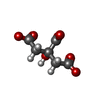
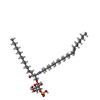

| #9: Chemical | ChemComp-FLC / |
|---|---|
| #10: Chemical |
-Details
| Has protein modification | Y |
|---|---|
| Sequence details | THE AUTHORS STATE THAT D201H IN CHAINS A AND E IS CORRECT AS PER BRADBURY ET AL, 1988 (PMID 2460336) ...THE AUTHORS STATE THAT D201H IN CHAINS A AND E IS CORRECT AS PER BRADBURY ET AL, 1988 (PMID 2460336). IN CHAINS B AND F, D85A IS A NATURAL VARIANT. CHAINS C AND G ARE CHIMERAS COMPRISING |
-Experimental details
-Experiment
| Experiment | Method:  X-RAY DIFFRACTION / Number of used crystals: 1 X-RAY DIFFRACTION / Number of used crystals: 1 |
|---|
- Sample preparation
Sample preparation
| Crystal | Density Matthews: 2.95 Å3/Da / Density % sol: 58.36 % |
|---|---|
| Crystal grow | Temperature: 277 K / Method: vapor diffusion, hanging drop / pH: 7.1 Details: 25% PEG3350, 0.1 M citrate/Bis-Tris-propane, pH 7.1, VAPOR DIFFUSION, HANGING DROP, temperature 277K |
-Data collection
| Diffraction | Mean temperature: 100 K |
|---|---|
| Diffraction source | Source:  SYNCHROTRON / Site: SYNCHROTRON / Site:  Australian Synchrotron Australian Synchrotron  / Beamline: MX2 / Wavelength: 0.95453 Å / Beamline: MX2 / Wavelength: 0.95453 Å |
| Detector | Type: ADSC QUANTUM 315r / Detector: CCD / Date: Apr 1, 2012 |
| Radiation | Monochromator: Si(111) / Protocol: SINGLE WAVELENGTH / Monochromatic (M) / Laue (L): M / Scattering type: x-ray |
| Radiation wavelength | Wavelength: 0.95453 Å / Relative weight: 1 |
| Reflection | Resolution: 3.1→140 Å / Num. all: 42432 / Num. obs: 42432 / % possible obs: 99 % / Observed criterion σ(F): 0 / Observed criterion σ(I): 0 / Redundancy: 4.2 % / Biso Wilson estimate: 90.04 Å2 / Rmerge(I) obs: 0.151 / Net I/σ(I): 8.3 |
| Reflection shell | Resolution: 3.1→3.27 Å / Redundancy: 4.2 % / Rmerge(I) obs: 1.107 / Mean I/σ(I) obs: 1.5 / Num. unique all: 6151 / % possible all: 99.7 |
-Phasing
| Phasing | Method:  molecular replacement molecular replacement |
|---|
- Processing
Processing
| Software |
| |||||||||||||||||||||||||||||||||||||||||||||||||||||||||||||||||||||||||||||||||||||||||||||||||||||||||||||||||||||||||||||||||||||||||||||||||||||||||||||||||||||||||||||||||||||||||||||||||||||||||||||||||||||||||||||||||
|---|---|---|---|---|---|---|---|---|---|---|---|---|---|---|---|---|---|---|---|---|---|---|---|---|---|---|---|---|---|---|---|---|---|---|---|---|---|---|---|---|---|---|---|---|---|---|---|---|---|---|---|---|---|---|---|---|---|---|---|---|---|---|---|---|---|---|---|---|---|---|---|---|---|---|---|---|---|---|---|---|---|---|---|---|---|---|---|---|---|---|---|---|---|---|---|---|---|---|---|---|---|---|---|---|---|---|---|---|---|---|---|---|---|---|---|---|---|---|---|---|---|---|---|---|---|---|---|---|---|---|---|---|---|---|---|---|---|---|---|---|---|---|---|---|---|---|---|---|---|---|---|---|---|---|---|---|---|---|---|---|---|---|---|---|---|---|---|---|---|---|---|---|---|---|---|---|---|---|---|---|---|---|---|---|---|---|---|---|---|---|---|---|---|---|---|---|---|---|---|---|---|---|---|---|---|---|---|---|---|---|---|---|---|---|---|---|---|---|---|---|---|---|---|---|---|---|
| Refinement | Method to determine structure:  MOLECULAR REPLACEMENT MOLECULAR REPLACEMENTStarting model: PDB ENTRIES 2AKR AND 4EI6 Resolution: 3.1→105.88 Å / Cor.coef. Fo:Fc: 0.901 / Cor.coef. Fo:Fc free: 0.897 / Occupancy max: 1 / Occupancy min: 0.48 / Cross valid method: THROUGHOUT / σ(F): 0 / SU Rfree Blow DPI: 0.383 / Stereochemistry target values: ML
| |||||||||||||||||||||||||||||||||||||||||||||||||||||||||||||||||||||||||||||||||||||||||||||||||||||||||||||||||||||||||||||||||||||||||||||||||||||||||||||||||||||||||||||||||||||||||||||||||||||||||||||||||||||||||||||||||
| Displacement parameters | Biso max: 222.1 Å2 / Biso mean: 100.8742 Å2 / Biso min: 31.75 Å2
| |||||||||||||||||||||||||||||||||||||||||||||||||||||||||||||||||||||||||||||||||||||||||||||||||||||||||||||||||||||||||||||||||||||||||||||||||||||||||||||||||||||||||||||||||||||||||||||||||||||||||||||||||||||||||||||||||
| Refine analyze | Luzzati coordinate error obs: 0.666 Å | |||||||||||||||||||||||||||||||||||||||||||||||||||||||||||||||||||||||||||||||||||||||||||||||||||||||||||||||||||||||||||||||||||||||||||||||||||||||||||||||||||||||||||||||||||||||||||||||||||||||||||||||||||||||||||||||||
| Refinement step | Cycle: LAST / Resolution: 3.1→105.88 Å
| |||||||||||||||||||||||||||||||||||||||||||||||||||||||||||||||||||||||||||||||||||||||||||||||||||||||||||||||||||||||||||||||||||||||||||||||||||||||||||||||||||||||||||||||||||||||||||||||||||||||||||||||||||||||||||||||||
| Refine LS restraints |
| |||||||||||||||||||||||||||||||||||||||||||||||||||||||||||||||||||||||||||||||||||||||||||||||||||||||||||||||||||||||||||||||||||||||||||||||||||||||||||||||||||||||||||||||||||||||||||||||||||||||||||||||||||||||||||||||||
| LS refinement shell | Resolution: 3.1→3.18 Å / Total num. of bins used: 20
| |||||||||||||||||||||||||||||||||||||||||||||||||||||||||||||||||||||||||||||||||||||||||||||||||||||||||||||||||||||||||||||||||||||||||||||||||||||||||||||||||||||||||||||||||||||||||||||||||||||||||||||||||||||||||||||||||
| Refinement TLS params. | Method: refined / Refine-ID: X-RAY DIFFRACTION
| |||||||||||||||||||||||||||||||||||||||||||||||||||||||||||||||||||||||||||||||||||||||||||||||||||||||||||||||||||||||||||||||||||||||||||||||||||||||||||||||||||||||||||||||||||||||||||||||||||||||||||||||||||||||||||||||||
| Refinement TLS group |
|
 Movie
Movie Controller
Controller



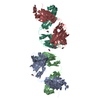
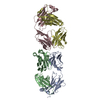
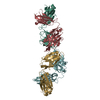
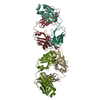
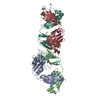
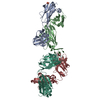
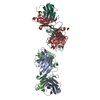
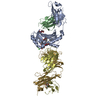

 PDBj
PDBj












